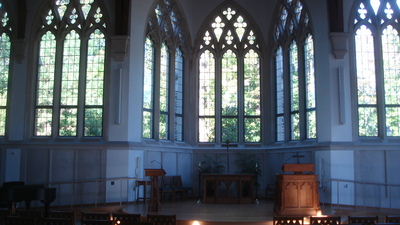Stuck on the back of Person Hall, at my alma mater, UNC is a statue of an archbishop, one Stephen Langton, late of Canterbury. The statue was rescued from some rubble somewhere between Big Ben and the Parliament building. You will notice the good bishop appears a bit tired, and he is holding a scroll. There is a reason. He’s the chap who is responsible for the division of the Bible into chapters and verses. Langton lived between 1158 and 1220, and is important for many reasons, not least was he was the negotiator between Pope Innocent III (his college chum in Paris) and King John Lackland, a negotiation that produced the forerunner of our Constitution and Bill of Rights, namely, the Magna Carta. But I digress. It was Langton who decided we needed the Bible divided up into proper soundbytes called verses and chapters, and their modern form as we know it in our English Bible is owed to his hard work. Though, it is true however that the ole boy must have been nodding some of the time, because some of the divisions make no sense (for example the ones in the middle of sentences which aren’t long). These chapter and verse divisions are no part of the original text of the Bible, and are not, alas, inspired, despite all the magical hocus pocus sometimes conjured up by Bibliophiles waxing eloquent about numerical connections between this chapter and this verse etc.
In fact there were good reasons there were no chapters and verses in the original language Biblical texts: 1) Arabic numbers hadn’t been invented yet; 2) papyrus was expensive and so scribes wrote in scriptum continuum, a continuous flow of letters without punctuation or division into words, phrases, sentences, paragraphs, or chapters; 3) letters of the alphabet were used in some ancient languages as numbers (think Latin— five is the letter V, ten is X, and so on). This of course explains why Jesus and some inspired NT writers when referring to a particular text in the OT may well says ‘it says somewhere in Isaiah….’. This is not because they are having a senior moment, its because there was no divisions or numbers to help them locate things. They simply had to have the text pretty much memorized if they were even literate, or at least know where in the document to find a passage they wanted to quote. Below you will find a poem I wrote about the form of the original Bible. Here I will just end by saying Archbishop Langton was important, and we all live with his legacy, for better or for worse. There would be no John 3.16 T shirts if it weren’t for him, no Tim Tebow eyeblack with Bible verses in them, etc. The impact of Langton ranges from the sublime to the ridiculous. It thus makes sense that he had been impaled on the back of a building at UNC, for there we find that same range of things being said about the Bible itself. But that’s a story for another day.
WORDSHAPED
Partial and piecemeal, here and there
Vowels omitted, consonants square
No jots or tittles, not one iota
As if there was, some sort of letter quota.
Line upon line, word for word
Nopunctuationseparationabsurd
Scriptum continuum without an end
Space is so precious, conventions must bend
Fair hand copy, stylus in hand
Awaiting dictation, write on demand
Line length is even, no letters odd
So it must be— the Word of God.
Written revelation, unveiled truth
Put on papyrus, sold from a booth
Unroll the scroll, unseal the seal
Meant to inform, not to conceal.
Nomina sacra, the Holy Name
In abbreviation, meaning the same
IX, XC, IHS too
Jehovah combines, God’s name times two.
Inspired authors, inspiring text
God breathed words, soul resurrects
Let it be written, let it be done
Fulfilling fulfillment, victory won.
In the beginning, God chose to speak
Creation created, in under a week
Even the last Word, God will have too
Alpha-Omega, indwelling you.
3/26/06

